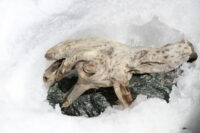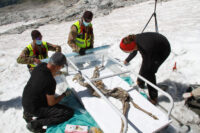 A chamois preserved for 400 years in the Ahrntal glacier in Italy’s South Tyrol will give researchers new information on how to conserve ice mummies that are increasingly at risk of exposure and decay due to glacier melt.
A chamois preserved for 400 years in the Ahrntal glacier in Italy’s South Tyrol will give researchers new information on how to conserve ice mummies that are increasingly at risk of exposure and decay due to glacier melt.
The goat-antelope died at an altitude of 10,500 feet and the ice preserved much of its skin. It was discovered by world champion skier and alpine enthusiast Hermann Oberlechner in the Val Audrina at a location so remote it can only be reached by a six-hour hike. The receding ice had exposed the hairless, leathern skin and Oberlechner realized this was not your usual animal carcass. He took a photo and mailed it to a park ranger and they notified cultural heritage officials of the find. (I mean, I barely get a bar a mile away from home where there’s moderate tree coverage, but he can send pics 10,000 feet up the Alps?)
 On August 26th, a team of Alpine Army Corps troops and experts from Eurac Research helicoptered to the Val Aurina to recover the carcass. The goat was chiseled out of the ice and fragments of its glacial context saved for further analysis.
On August 26th, a team of Alpine Army Corps troops and experts from Eurac Research helicoptered to the Val Aurina to recover the carcass. The goat was chiseled out of the ice and fragments of its glacial context saved for further analysis.
The goat was transported to a Eurac laboratory in Bolzano where it will be studied further with the aim of establishing the most effective protocol to conserve ice mummies exposed by rapidly receding glaciers. Researchers will also investigate how best to protect ancient DNA in mummified remains.
In mummified specimens, DNA has often degraded and is present only in minimal amounts. In fact, faced with a new discovery, the first question experts encounter is how to examine the mummy while continuing to preserve it, without damaging its ancient DNA. Every action has irreversible consequences on DNA fragments, which makes experimenting with new techniques on human finds impossible. Contrastingly, an intact animal mummy is a perfect simulant for research – especially if its conditions are similar to those of the world’s other ice mummies, of which Ötzi and the Inca girl Juanita are among the most famous. “Thanks to our previous studies we know the optimal physical and chemical parameters for preservation from a microbiological point of view. In the laboratory we will bring the chamois to those conditions and focus on their effects on DNA. With repeated in-depth analysis we will verify what alterations the DNA undergoes when external conditions change,” explains Marco Samadelli, conservation expert at Eurac Research. “Our goal is to use scientific data to develop a globally valid conservation protocol for ice mummies. This is the first time an animal mummy has been used in this way,” adds Albert Zink, Director of the Institute for Mummy Studies at Eurac Research.
This video shows the painstaking process of removing the chamois mummy from its icy grave, how it was exposed, how ice chips and organic materials were bagged and how the body was transferred onto a custom-made stretchery thing (not a stretcher at all, really, more like plastic bed with ribs so it could be covered with a tarp without touching the remains).
To me, the Institute for Mummy Studies at Eurac Research seems to the one that –at the museum in Bolzano– is taking care of ‘Ötzi’ himself. Would that be correct, or are those different entities?
Also, could they possibly have used satellite communication or more down-to-earth peer to peer radio transmission?
:hattip:
I mean, I barely get a bar a mile away from home where there’s moderate tree coverage, but he can send pics 10,000 feet up the Alps?
That is why we are not world champion skiers and he is 😉